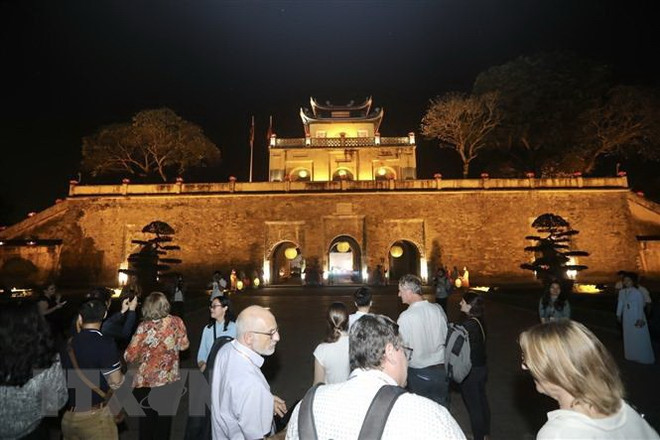 More than 300 delegates attending the 12th Vietnam-France decentralisation cooperation conference experienced a night tour to explore the Thang Long Imperial Citadel on the night of April 15. (Photo: VNA)
More than 300 delegates attending the 12th Vietnam-France decentralisation cooperation conference experienced a night tour to explore the Thang Long Imperial Citadel on the night of April 15. (Photo: VNA)Hanoi (VNA) – The capital city of Hanoi has spared no expense in renovating andpromoting its heritage sites while seeking new ways for sustainable preservation.
Hanoi is home to morethan 1,200 recognised relic sites, accounting for one-third of this type of valuable site nationally.
It can be said thatHanoi preserves a huge amount of cultural heritage for the country, Deputy Minister ofCulture, Sports and Tourism Hoang Dao Cuong said at a meeting heldon April 18, aiming to review the implementation of a project on the preservationof Thang Long Imperial Citadel and the Co Loa relic site, and setting key tasksfor 2023.
The Ministry ofCulture, Sports and Tourism (MoCST) recognised Hanoi’s investment inthe restoration of relics, especially according to a resolution of the city’s PartyCommittee on spending morethan 4 trillion VND (170 million USD) on 500 sites, he said, noting that itwill contribute to preserving cultural heritages of the nation.
Over the recent years, the relics under themanagement of the department have been well restored and preservedto promote their values, according to Hanoi’s Department of Culture and Sports. As a result, since 2015, the Thang Long Imperial Citadel,the Temple of Literature and Hoa Lo Prison - the key sites of the city - have welcomed millions ofdomestic and foreign visitors each year.
Nguyen Thanh Quang,director of the Thang Long – Hanoi Heritage Conservation Centre, said as of April15, 250,640 tourists had visited Thang Long Imperial Citadel and 135,379 toured Co Loa relic site. Revenue from fees andcharges reached 5.62 billion VND, which equals 80% of the assigned plan.Especially, more than 300 delegates attending the 12th Vietnam-Francedecentralisation cooperation conference experienced a night tour to explore theThang Long Imperial Citadel which was recognised by UNESCO as a WorldHeritage Site in 2010 - on the night of April 15.
Regarding Kinh ThienPalace – the most important building in the citadel, Hanoi has soughtrecommendations from international experts to preserve the relic.
The municipal People’sCouncil has issued resolutions relating to the approval or adjusting investmentpolicies for a number of projects using the city’s public investment capital. Some examples are the conservation project of the archaeological site at 18 Hoang Dieu Street;upgrading of An Duong Vuong Temple and Ngoc Well; upgrading of Co Loa CommunalHouse or Ngu Trieu Di Quy and My Chau Temple; and a project on building atemple dedicated to King Ngo Quyen.
Hanoi is mobilising all resources to protect andpromote the values of the city's intangible cultural heritage under a planuntil 2025.
The municipal Department of Culture and Sports is tasked with closelycoordinating with relevant agencies, local authorities and communities indeploying solutions to protect the heritages. Dissemination campaigns will belaunched to introduce the intangible heritage value to both Vietnamese andinternational visitors, contributing to enhancing the community awareness of the work.
The city will compile scientific dossiers for several local intangiblecultural heritages to submit to the MoCST seeking inscription of them on the list of national intangiblecultural heritage, as well as develop publications on the heritages. Trainingcourses will be organised to improve the practice or performance skills fortypical intangible cultural performances that are on the verge of disappearing.
Favourable policies will be issued for artists along with the restoration ofvarious types of intangible cultural heritage. The city will encourage andfacilitate the collection and introduction of these heritages by bothorganisations and individuals.
The city will promotesocialisation of resources to preserve and promote their value by attractingthe attention and support of organisations, individuals, and businesses in thefield.
With 1,793 intangiblecultural heritages, including three UNESCO-recognisedIntangible Cultural Heritages of Humanity, the capital city is one of the communities with the richest traditions in Vietnam./.





























